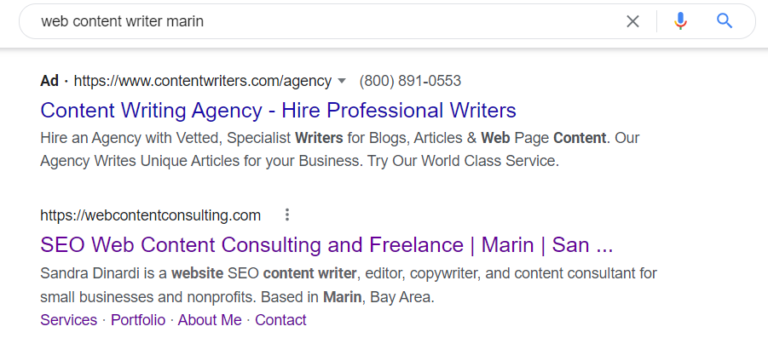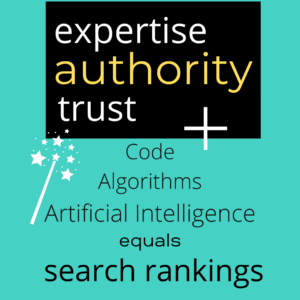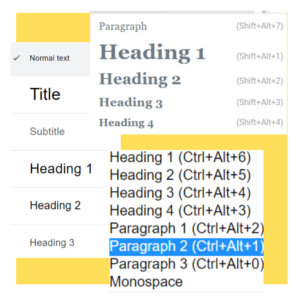Jump to Audio Version to Listen instead
Improve your website’s visibility and user experience with SEO and content marketing best practices. The SEO world has a lot of information to know, so I’ve put together this summary of SEO and content marketing tips/info to help you get started. Included are reference links for a deep dive of knowledge from some of the top SEO industry experts. I am also a small business owner, and it is important for me to share my knowledge with you. I hope this helps take the guesswork out of jumping into learning about SEO and content marketing for your small business.
TL;DR Use content marketing foundations blended with SEO techniques to improve content quality, search rankings, and user experience. Here are 6 steps to get you started and reference links from industry experts for a more in-depth look.
- Write content for your audience.
- Keep your content fresh and unique.
- Encourage quality backlinks with sharable, informative, trustworthy, and compelling content.
- Include Calls to Action within your content to move your customer along the buyer’s journey.
- Complete local keyword research and embed it naturally in your content – keywords, phrases, and topics that your audience would use to query and find your business.
- Use headers to organize your content for a better user experience and help the search engines understand the context and organization of your site’s content.
What is SEO and why should you care about it for your small business?
First, let’s start with what is Search Engine Optimization or SEO. It can seem mysterious and complicated to many people, but it is easy to understand with a bit of education. SEO is the action you take to increase your website’s visibility on the Search Engine Results Pages or SERPs such as top search engines Google and Bing. When you practice optimization, the activities might require technical updates, content improvement, and marketing tasks. You can find a good definition of SEO here from Moz.
This image below is a SERP for the phrase ‘web content writer marin.’ The page displayed several ads at the top and then my website URL, Web Content Consulting. It is the top organic site on page 1 of the search results. A page one search result means nothing if my audience doesn’t use that search term and my content isn’t providing the information they are looking for.

Why do you want to increase the visibility of your website?
Well, with so much similar content out there on the web, globally, regionally, and in your immediate locale, it would be to your advantage to share your niche content that makes your business stand out from the rest. All businesses have a quality that is different than the other. You need to bring those qualities up front and not be drowned out by your competition. Don’t miss an opportunity to take advantage of customer reach through the internet; we are in the digital age, after all. And as noted by the Pew Research Center, 93% of adults use the internet.
Your customers are looking for your business, product, or service on the internet using their phones, laptops, and tablets. They are asking questions and looking for answers. Your website gives you the podium to present you and your business. There is a term to be familiar with called E-A-T, otherwise known as Expertise, Authority, and Trust. Your website content should satisfy those points to satisfy your audience and, in return, better search results. This E-A-T concept is a very high-level description that comprises the intent of how search engine signals or conditions rank website content through the magic of code, algorithms, and AI.

SERPS and User Experience
With relevant SEO content, you provide the search engine crawlers information it needs to deliver SERPs to users searching for your business information, products, and services. The search engine decides if the content is better than your competitors and ranks it accordingly. Search engines are complex systems and more intelligent today than only a few years ago with the improvement and application of AI (artificial intelligence and deep learning).
While keywords and exact matching phrases used to be one of the primary signals for optimizing your web pages, now there is a combination of factors as the search engines discover and understand the context of your content. Those factors are not all known and are kind of a black box of information. Companies like Google and Microsoft won’t give away all their technical details. But, you can find Google’s search advocate, John Mueller, answers SEO questions in forums and Twitter. He dispels SEO myths and outdated SEO techniques.
Also, the SEO community shares their experience with optimization from years of trial and error, testing, and metrics. One thing is for certain from all this information accumulated, we know creating quality content will give you a head start on search engine optimization.
Why so much focus on quality? As mentioned previously, your website could rank #1 on the first page in the SERPs, but if the user experience is terrible or content is irrelevant, customers will leave your site in a hurry without taking any action.
Content Marketing blend with SEO - Getting Savvy
I spoke a lot about SEO and quality content, let’s take a step back to the foundations of content marketing. Content marketing as described by HubSpot is “the process of planning, creating, distributing, sharing, and publishing content to reach your target audience. It can boost factors like brand awareness, sales, reach, interactions, and loyalty.”
Suppose you are already familiar with the exercise and approach of content marketing; this is awesome because applying good content marketing practices blended with SEO is the best approach. Can you tell in the list below which is content marketing vs. SEO? Some say content marketing is the new SEO or SEO is the new content marketing. Either direction you look at, the lines start to blur on where one starts and the other ends.
What does this all mean for you? Whether you take on the work yourself or hire someone for SEO content services, it is good to understand and set your expectations. The tasks will require planning and time. It is an iterative process, and the results are not immediate. Patience will be key.
Are you ready? Let’s get started.
Six Tips to get you started on your SEO content journey
- Write content for your audience.
- If you have already created user personas, great. User personas will help you strategize creating the best content for your audience.
- If not, check out this guide on creating user personas from Niel Patel.
2. Keep your content fresh and unique with SEO content writing and copywriting
3. Be informative, trustworthy, and compelling.
- Answer your audience’s questions through informative blogs, FAQs, and landing page content.
- Make sure your content is shareable. If an authoritative industry-related company, blogger, or influencer references your page URLs in their content, this creates backlinks back to your site. Their audiences will become your audience. The key point here being authoritative in their industry. Website links associated with spammy websites i.e. unrelated and irrelevant, will affect your rankings negatively.
- Spammy backlinks, unfortunately, are mostly out of your control when others are sharing, but there are ways to combat bad backlinking (more info for another time). The ones that are in your control are by not hiring people who provide SEO services promising page one rankings.
- Be wary of anyone who promises guaranteed backlinks and provides suspect information on how they plan to achieve it. These are called black hat SEO techniques where they find ways around the system, and attain undeserved traffic. These techniques will affect your website rankings negatively.
- There are guidelines we need to follow for positive search ranking. Anyone you hire should be aware of these guidelines and follow them.
- Also, Read more on how to build quality backlinks to improve your growth organically.
- Include Calls to Action for your customers’ at all stages of the buyer’s journey.
- Tie main keywords and topics into your content naturally.
- These keywords, phrases, and topics should be relevant to what your audience is most likely to query, including attributes that make your business stand out. Investing time in local keyword and topic research is a must and will help you create a good list to use in your content that will get picked up in your locale. Answer the Public is a nice free tool to research what content is ranking for specific terms. There are, in fact, a lot of free tools you can use. Compare the results of a few to help narrow down the list. When you have decided on the words to focus on, these keywords and phrases should be embedded naturally. They are what binds your content to user queries.
6. Use headers to appropriately section and order your content.
- Create header descriptions relevant to the section. Headers may include some of the keywords, phrases, or topics you found in your research. Header text tags are designated by H and a number, like H1, H2, and so on.
- Like Google Docs or Word docs, your website CMS (content management system) allows you to set the type. Use headings to organize the content for easier scanning and reading. Headers also help with accessibility for users who use screen readers.
- Organized content creates a good user experience and helps the search crawlers have a better understanding too.

Website Analytics
Don’t forget to track your analytics – start with finding out your metrics before you make changes. Then analyze points in time after the changes are made. Here are the links to set up Google Analytics and Google Console.
As a business owner, understanding key metrics about your business is important, including understanding your website’s performance. Tracking the performance of your SEO changes will take time, three months to a year, with minor adjustments along the way.

What's Next?
In the next series of posts, I’ll dig a bit further into how to customize title tags, page meta-descriptions, understanding page loads, tools knowledge, and more. Digesting all this info into smaller bits is the best way to absorb, learn, and implement.
Do you have questions, comments, suggestions? Please note them in the comments below or send me an email. I’m happy to help answer questions and have a discussion about your content and SEO.
Reference Links
- What is SEO https://moz.com/learn/seo/what-is-seo
- Internet Fact sheet https://www.pewresearch.org/internet/fact-sheet/internet-broadband/
- Expertise, Authority, and Trust https://ahrefs.com/blog/eat-seo/
- Google forum https://t.co/Bp06bH2ltx?amp=1
- Content Marketing https://blog.hubspot.com/marketing/content-marketing
- User Personas https://neilpatel.com/blog/user-personas-for-seo/
- SEO Content Writing vs. Copywriting https://www.searchenginejournal.com/seo-content-writing-vs-seo-copywriting/
- Google’s Webmaster Guidelines https://developers.google.com/search/docs/advanced/guidelines/webmaster-guidelines
- Bing’s Webmaster Guidelines https://www.bing.com/webmasters/help/webmasters-guidelines-30fba23a
- Building Quality Backlinks https://blog.hubspot.com/marketing/backlink-strategies
- Buyers Journey https://blog.hubspot.com/sales/what-is-the-buyers-journey
- Answer the Public Free SEO keyword tool https://answerthepublic.com/
- Google Analytics https://analytics.google.com/analytics/web/
- Google Console https://search.google.com/search-console/about
Audio Blog
See where your site currently stands with SEO, Quality, and User Experience.
Sign Up Below to get on the queue for the $300 Content Strategy Review package.
I’ll be in touch soon to discuss your business goals. Get the most of the review.